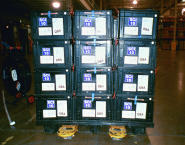May 1, 2003 – After a successful pilot RFID deployment at its own third-party logistics operations in Austin, Texas, tote management company Beal Solutions will roll out RFID across its international operations, and it plans to market the back-end software it developed to process and analyze RFID data.
“The pilot provided the proof of technology that will enable us to start marketing our own supply chain visibility software,” says Beal Solutions Chairman and CEO Mike Beal.
Beal Solutions was spun out from Dell Computer in 2001. The company manages totes – reusable containers – which are used to transport and manage high-value electronic components from printed circuit board suppliers. Typically, Beal picks up the parts or receives delivery from distribution partners and then delivers them to PC manufacturers.
The pilot used RFID hardware from Alien Technology and was designed and implemented by RFID systems integrator Xterprise. Xterprise also completed a pilot with Lionize Logistics recently (see RFID Lionized After Warehouse Pilot).
For the Beal project, Xterprise attached passive RFID labels to individual totes at the origin of shipments. When the shipments arrived at Beal’s warehouse, the tags were scanned automatically by readers at the dock door as the totes were unloaded. Each pallet can ship with as many as 50 totes that are often double-stacked. “The pilot cut receiving time by at least half and probably much more,” said Beal.
The data read from each RFID label was fed into Beal’s own supply chain software, dubbed the Helm. The standalone Web-based platform automatically receives data from RFID hardware to give real-time visibility into the status of its totes and the company’s supply chain. That information can also be shared with its suppliers and customers through the software platform.
One obstacle the team faced was tagging electrically “conductive” carbon-filled totes. The industry uses these special totes prevent the build up of electrostatic energy, which could discharge and damage the equipment. RF energy could not penetrate the totes, and because the totes are conductive, putting a metal antenna directly on them would short it out the tag, making it impossible to read any data off of the chip.
To get around the problem of shorting out the tag, Xterprise taped the tags on a piece of plastic that was recessed into a ribbing of the tote, so it was sitting half an inch from the carbon-filled material. “That gave us enough isolation for the tag so that we did not have any problem reading the tags,” says Dean Frew, president of Richardson, Texas-based Xterprise.
To cope with the fact that the tags could not be read through the totes, the team put one tag on each side of the tote. That way, regardless of how the tote was stacked on the pallet, at least one tag would be facing outwards, toward a reader at the side of the dock door.
Because two tags were needed, the price of the tags was a consideration for the pilot. The decision to use RFID from Alien Technologies was based on performance capabilities, as well as the price of the labels — around 45 cents each. “Alien’s products enable the RFID tags to be read with 100 percent reliably from more than nine feet [three meters] on a conductive tote,” says Frew.
Xterprise used a linear polarized antenna, which provides extra range and penetration because the RF energy is directed into a narrow band. The systems integrator also used I-shaped tags that are designed to be read by such antennas. The set up provided an additional six feet (two meters) of read range.
Beal Solutions is set to roll out similar RFID systems in its operations in Mexico and China, but the company plans to keep its existing active (battery-powered) RFID system. Says Beal: “There are situations where you need the extended read range that active tags provide.”


